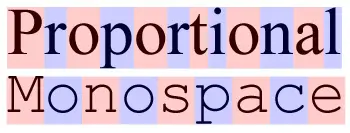Do you hit the space bar twice after you type a sentence?
If you do, you should give some thought to stopping.
The post-sentence double-space is the appendix of typography. It doesn't serve any real purpose. It doesn't even need to be there. We would probably be better off if it wasn't there in the first place. Some people do it because that's how they learned to type and it's a force of habit. And some people don't even notice it (although after reading this, you'll never not notice it--it's one of those things).
Ultimately though, it's worth cutting out.
THE ROAD TO ADDICTION
Let's start with a little history lesson. Where did this typing quirk come from?
There are two types of fonts. Monospaced and proportional. In a monospaced font, like Courier, each letter takes up the same amount of space. So the letters O and I would take up the same amount of real estate on a line of text. A proportional font is the opposite of that (and it's also the kind of font in which this article is typed); each letter takes up a different amount of space.
See, here:

Got it? Good. Because it's helpful to know going forward.
This is from Wikipedia:
Until the 20th century, publishing houses and printers in many countries used single, but enlarged, spaces between sentences. There were exceptions to this traditional spacing method—printers in some countries preferred single spacing. This was French spacing—a term synonymous with single space sentence spacing until the late 20th century. Double spacing, or placing two spaces between sentences (sometimes referred to as English spacing), came into widespread use with the introduction of the typewriter in the late 19th century. It was felt that with the monospaced font used by a typewriter, "a single word space ... was not wide enough to create a sufficient space between sentences" and that extra space might help signal the end of a sentence. This caused a widespread change in practice. From the late 19th century, printers were told to ignore their typesetting manuals in favor of typewriter spacing; Monotype and Linotype operators used double sentence spacing and this was widely taught in typing classes.
So double spacing after a sentence was an aesthetic quirk, and not even a widely accepted one. The entry goes on to state that "with the introduction of proportional fonts in computers, double sentence spacing became obsolete, according to many experts."
That's the origin, and it's not even a very interesting one. Just one of those things that someone thought up which caught on.
And it's important to know that nobody is going to die if you double space after a sentence. There are much worse things you could do in this life. Still, it's a habit very much worth breaking.
SIDE-EFFECTS
Publishing is a game of inches. Say you write a novel and you query it out to agents. That agent is getting hundreds of other queries. Some will be better than yours, some will be worse, and some will be just about the same. And that's why you need to make sure that everything you can control is perfect. So no typos. Spell the agent's name right. And take out that damned double space.
It seems silly, right? That something like this might work against you. It's not even technically wrong.
I'm not saying that if you space twice after a sentence that an agent is going to toss your work in the trash. What I am saying is this: Even on a subconscious level, it could work against you. Some people see it and bristle. And it will never work against you if you don't double space. So why not stop doing it?
Eliminate that double space and your writing will be much tighter, and you'll avoid troublesome mistakes like sentences that don't line up right with the left edge of a paragraph.
On top of that, your novel? The one that was accepted by an agent who overlooked your weird spacing habits? It's not going to stay that way when it lands a publishing deal and heads off to the press. All those extra spaces are coming out. And will someone please think of the typesetters?!
RECOVERY
I have a confession to make. I used to be a double-spacer. Then one day I decided I wanted to change. I thought it would be a tough road. When I'm in the zone I type around 100 words per minute (an average typist clocks in at 50-80). I type from instinct and figured the double-tap was so ingrained I would never get around it (which is the same reason I've flirted with, but never committed to, switching from a QWERTY to DVORAK keyboard layout).
But you know what? After three sentences I broke the habit and I've never looked back.
At the time it felt like a small victory. I was sitting on a 90,000 word manuscript riddled with those extra spaces. I hate keying in copy edits (like, hate hate it), and I wasn't looking forward to sitting there and clicking the damn backspace key a million times.
Then I discovered a fix. And it is dead simple. Follow these simple steps:
- Go to Find/Replace
- In the Find box, hit the spacebar twice
- In the Replace box, hit the spacebar once
- Hit Enter
And that's it. You're done. Watch as your manuscript goes on a crash diet, shedding pages and white space.
IN CLOSING
Like I said, there are more egregious mistakes you could make in life. And it's not like double spacing is on the same level as using their or you're incorrectly. But any opportunity you can take to make your work better or stronger is an opportunity worth taking. And some people are going to look at that extra white space after your sentences and they're going to roll their eyes. This is something you can control. And be honest with me for a second. I double-tapped on this paragraph. And now that it's in your head, doesn't this just look wrong?

About the author
Rob Hart is the class director at LitReactor. His latest novel, The Paradox Hotel, will be released on Feb. 22 by Ballantine. He also wrote The Warehouse, which sold in more than 20 languages and was optioned for film by Ron Howard. Other titles include the Ash McKenna crime series, the short story collection Take-Out, and Scott Free with James Patterson. Find more at www.robwhart.com.







